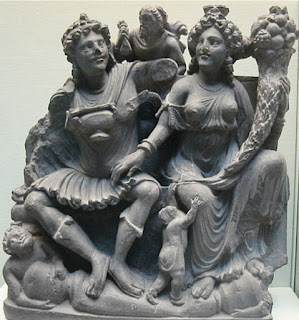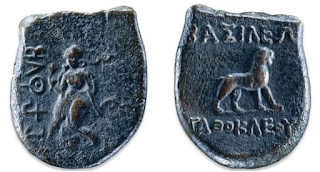Lakshmi, also known as Shri, is one of the principal goddess in Hinduism. She is the goddess of wealth, fortune, power, beauty and prosperity. Along with Parvati and Saraswati, she forms the Tridevi of Hindu goddesses. The wife and divine energy of Vishnu, she is said to have taken different forms to be with him in each of his incarnations.
In the epic Mahabharata, Lakshmi was born from the stirring of the primeval milky ocean by God. Following the intervention of Brahma and Vishnu, she miraculously appeared from the sea, of clarified butter clothed all in white and radiating youth and beauty. Lakshmi personifies wealth, grace, charm and splendor. The goddess is particularly is associated with the lotus flower. In her iconography, she is either sitting or standing on a lotus and typically carrying a lotus in one or two hands. She is particularly worshipped in the annual Diwali or ''Festival of lights'', celebrated every year.
Gaja Lakshmi
Lakshmi is mentioned in the Rigveda, an ancient collection of Vedic Sanskrit hymns. In Atharva Veda, (the text is the fourth Veda), Lakshmi evolves into a complex concept with plural manifestations. In Book 12, Chapter 5, Lakshmi connotes the good, an auspicious sign, good luck, good fortune, prosperity, success and happiness. In Shatapatha Brahmana ( a commentary on the Sukla Yajurveda, it contains detailed explanations of Vedic rituals, symbolism and mythology), Sri (Lakshmi) is part of one of many theories, in ancient India, about the creation of the the universe. Shakta Upanishads are dedicated to the Tridevi of goddesses, Lakshmi, Saraswati and Parvati. Numerous ancient Strotam and Sutras of Hinduism recite hymns dedicated to Lakshmi. Most, if not all the ancient Hindu epics describe goddess Lakshmi. She has been praised with more than 1000 names.
Ashta Lakshmi, is a group of eight secondary manifestations of Lakshmi. The Ashta Lakshmi presides over eight sources of wealth and thus represents the eight powers of Shri Lakshmi. These manifestations include, Adi Lakshmi, Dhanya Lakshmi, Veera Lakshmi, Gaja Lakshmi, Santana Laksmi, Vidya Lakshmi, Vijaya Lakshmi and Dhana/ Aishwara Lakshmi.
Ashtalakshmi- Eight forms of Lakshmi Goddess
In other religions too, Lakshmi is a revered deity in various forms. In Jainism, Buddhism, (Buddhist sects of Tibet, Nepal and Southeast Asia). In Chinese Buddhism, Lakshmi is referred to as either Gondetian or Jixiang Tiannu. In Japan, she is known as Kishijoten, and is the goddess of fortune and prosperity. In Bali, she is worshipped as Dewi Sri.
The Japanese Kishijoten is adapted from Lakshmi
Dewi Sri, is a native to Java after adoption of Hinduism as early as the first century, she was equated with goddess Shri Lakshmi
Gajalakshmi. Meaning Lakshmi with elephants, is one of the most significant Ashtalakshmi. The goddess is siting on a lotus, flanked on both sides by an elephant (gaja). The elephants are pouring water from their trunks, depicting prosperity, good luck and abundance.
Gajalakshmi at Shravanabelagola Temple, Karnataka
Gajalakshmi, Sanchi,
An image is found from the 2nd century BC, possibly in Buddhist contexts and appears on the railings from the Buddhist site of Bharhut, from 125-100 BC. Gajalakshmi is represented in the oldest surviving stupas and cave temples of Buddhism. To feature important events in the life of Buddha without engraving his idol (as then norms did not allow engraving of Buddha), was the most difficult task. Gajalakshmi sculpture was created for this symbolism by the artists. Goddess is the earth, elephant is the anointing of the cloud, Abhishek is rain. The lotus is clean spontaneously after a rain. Thus it portrays new creation and the birth of Gautam Buddha is the invention of a pure, clean and eternal essence
Gajalakshmi appears on coins of King Agathokles, of Bactria in the 2nd century BC, on a 1st century BC coin of Azilises, an Indo-Scythian king who ruled in Gandhara, 57-35 BC, on Kuninda coins of 2nd century BC and on later coins of Kausambi, Mathura Bijaasata Mitra and Visaka Deva. Coins were issued by Satkarni in the 1st century, Jayanagar (8th century AD) and Nayak Kings of Tamil Nadu too. Gajalakshmi is worshipped in many parts of Asia and the world. In Sri Lanka, we find coins of 1st century AD with Gajalakshmi.
The Gundestrup Cauldron. Perhaps the world's most famous silver bowl, found over a hundred years ago, in 1891, in Jutland in Denmark. Dated around the middle of the 2nd century BC and decorated with various scenes of sacrifices and wars and deities. An interesting depiction on the inner Plate ''B'', shows a goddess flanked by elephants, the Gajalakshmi. The iconography may be Indic as the elephants are totally out of context in Europe. The National Museum of Denmark asked where it would have been made, as the figures represent foreign gods and animals. Many historians believe three figures on the Cauldron have Indian links, the Gajalakshmi, the wheel god, Vishnu and goddess Hariti. Although it is believed to be of Celtic origins, Celtic Buddhism now after a lot of research seems a reality, and answers some questions.
Ardoksho. An Iranian goddess, said to be the goddess of prosperity and was a female deity of the Kushan Empire, in central and South Asia during the early part of the 1st millennium AD. She is also known by alternate name of Lakshmi, Shri. The couple Ardoksho and Pharaho, is found on a lot of artefacts. Ardoksho holds the cornucopia, a multi-seeded fruit, considered to be the symbol of creation.
From the first two centuries, about nine forms of Ardoksho have been observed on the coins minted. The Gupta gold coins are considered the most extraordinary examples of Numismatics and artistic excellence. These coins in general depicted the ruling monarch on the obverse while the reverse depicted the figure of a goddess. Ardoksho was retained on the reverse of the early Gupta coins, but was transformed into her Indian counterpart, Lakshmi, with a lotus in her hand, first seated on the throne and later on a lotus.
Earliest Coins depicting Goddess Lakshmi.
Agathocles I Dikaios was an ephemeral Greco-Bactrian/Indo-Greek king who reigned between around 190 and 180 BC. He was unique in issuing bilingual coinage. The obverse of the coins had his portrait in Greek, while the reverse had imagery from Buddhist and Hindu pantheon alongside inscriptions in Brahmi/ Kharosthi.
Bactria, Agathocles, 185-170 BC, Double Karshapana, weight 14.4 gm, Obverse: Goddess Lakshmi holding flower, Brahmi legend, ''Rajane Agathukleyasasa'', Reverse: Lion standing right, Greek legend,
Bactria, Agathocles, 185-170 BC, Obverse: Goddess Lakshmi holding flower, Brahmi legend, ''Rajane Agathukleyasasa, Reverse: Lion standing right, Greek legend,Bactria, Pantaleon, 185- 180 BC, weight 13.0 gm, Obverse: Lakshmi walking left, holding flower, Brahmi legend ''Rajane Patalevasa'', Reverse : Lion standing right, Greek legend
Kuninda Coins. (2nd century BC to 3rd century AD)
Kuninda, Amoghabhuti, silver Drachm, 2nd century BC, weight 2.1 gm, Obverse: Deer standing right, Goddess Lakshmi standing right holding long stemmed lotus, srivatsa above, Brahmi legend around ''Rajnah Kunindasya Amoghabhutisya Maharasya'' around, three arched hill between deer legs, Reverse: Six-arched hill with nandipara above, swastika and split standard left, railed tree at right, river below and Kharosthi legend around
Ujjayini, Gajalakshmi, copper, weight 4.4 gm ,Obverse: Lakshmi seated in center flanked by two elephants standing, holding water pots in their trunks, Reverse: Ujjaini symbol
Gajalakshmi, Copper 3/8th karshapana, weight 4.1 gm, 200 BC, Abisheka-Lakshmi type, Obverse: Lakshmi seated with feet parallel to each other, right rests on her belly and her left on her leg: Lakshmi is flanked by two elephants which are sprinkling water on her head. Reverse: Ujjaini symbol
Goddess Lakshmi depicted on Kushan and Gupta Coins
































No comments:
Post a Comment
Any inputs or feedback is welcome!